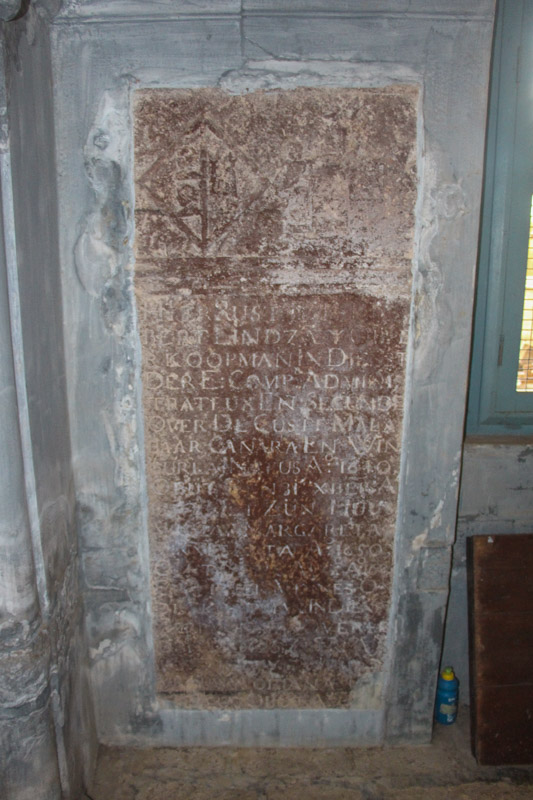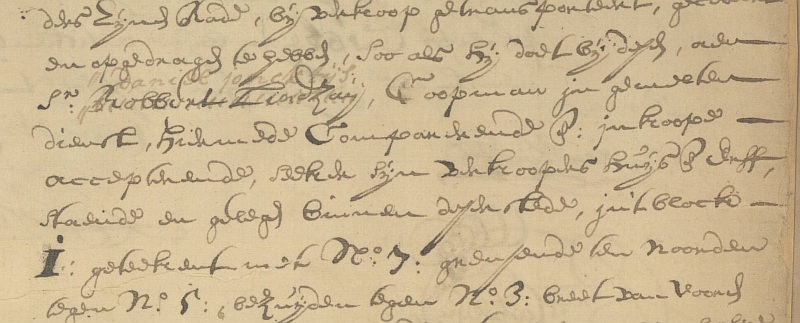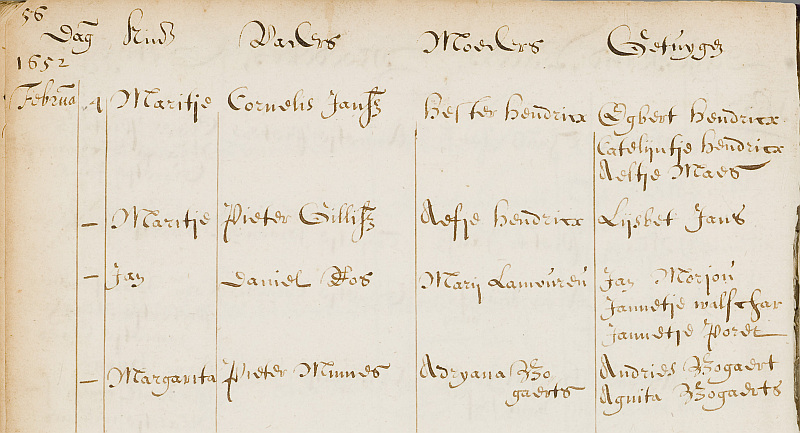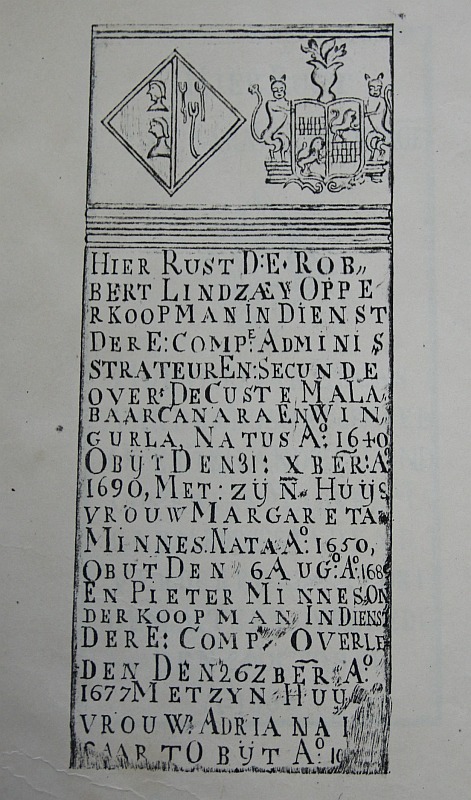Fort Kochi - Robbert Lindzaij
Just as would have happened in the Netherlands, Robbert Lindzaij, administrator and secundo over the coast of Malabar, Canara and Wingurla, was buried in the church after his death. In this case, in St. Francis Church in Cochin. After closing his eyes forever on New Year's Eve, 31 December 1690, he was the last to be buried in the family grave. His wife, Margrita Minnes, and her parents, Pieter Minnes and Adriana Boogaerts, had preceded him. The tombstone makes it clear that Robbert Lindzaij is the most important person in the grave. Because of his high position, the funeral must have been accompanied by much ceremony.
 Monument of Robbert Lindzaij in the St. Francis Church Fort Kochi
Monument of Robbert Lindzaij in the St. Francis Church Fort Kochi
Because of his Scottish-sounding surname, it was long thought that Robbert was a Scottish soldier, but nothing could be further from the truth. He was born in 1640, the son of Pieter and Margrita Chien, in The Hague, the capital of Holland.[i] He was only 14 or 15 years old when he sailed from Zeeland on the "Mars" in April 1654 and arrived in Batavia on 9 January 1655. According to the pay books, he made the trip as a passenger. In 1656 he entered the service of the VOC, as a junior assistant, on the island of Ceylon. In 1664 he was allowed to call himself an assistant and started earning twenty guilders a month. Robbert apparently did his job well, because already in 1667, when he was 27 years old, he was appointed sub-merchant with a salary of forty guilders a month. Because the coast of Malabar was part of the comptoir Ceylon, it is not clear when he received his first appointment along the Malabar coast. Probably not long after the conquest in January 1663 and a lot of personnel was needed to man the posts. In 1666 he was employed as an assistant to the sub-merchant Jacob Chardevene and was ordered to come to Batavia with the books of Calicoijlan[ii] for an inspection in connection with major shortages.[iii] The governor of Ceylon does not see the point of this. So, it remains to be seen whether the trip has continued. On 19 November 1671, Lindzaij was sent to Bassalor as a sub-merchant[iv] to put the books in order with his colleague Bruijn. In doing so, they promise to "try" to behave in such a way that the governor will have no reason to be dissatisfied.[v] For now, everyone seems satisfied with them. He was probably still a bachelor when he bought a house in the Breedestraat in Cochin on 2 May 1675.[vi] Maybe he bought it to give shelter to his "play child" Pieter. Despite not being married to the mother, the boy will receive his surname and will also receive a large bequest from his father's inheritance. Margrita Minnes, the widow of Jacob Chardevene, merchant and chief of the Coijlan fort and his former boss, became his wife. Chardevene died in August 1676, leaving his widow a good 2,100 rijksdaalder and seven slaves.[vii] The rules of the VOC were strict with regard to European women who became widows. Because the VOC had a maintenance obligation towards them, they were forced to return to "the fatherland". This was also the rule for widows born in the East to a European father. The alternative was to remarry quickly. For practical reasons, it was allowed to remarry after three months.
The house in Cochin may also have been bought as an investment, as Robbert was usually stationed at one of the outposts along the coast. He can be found at posts in Bassaloor, Calicoijlan, Coilon, Suratte and Wingurla. At the end of 1685, he and his family had to flee the latter place on the ship Bovenkarspel when the Mongols attacked the city.[viii] Back in Cochin, they went to live in the house on Breestraat that he had bought in 1679 and was located next to his first house. It must have been considerably larger, because in addition to the family, it must also accommodate his 21 slaves and a slave child.[ix] He has now also received company from the Netherlands. His brother-in-law Daniel van Tongeren arrived in Cochin in 1680 as a corporal and a few years later his sister Christina followed her husband to Cochin. She did not stay long, because in 1690 she was back in the Netherlands while Daniel remained in Cochin. On 7 August 1689 Margrita died and was buried in the family grave in the church of Cochin where her parents were buried.
 Deed of sale of the second house (NL HaNA 1.11.06.11 3 0109).
Deed of sale of the second house (NL HaNA 1.11.06.11 3 0109).
Pieter Minnes, pharmacist of Rotterdam, and Adriana Boogaerts of Delft are Margrita's parents. They married on 31 May 1651 in Delft and had children Margrita and Willem in their house on the Jacob Gerritsstraat in the heart of Delft. Margrita was baptized on 4February 4 1652 and William on 14 May 1653.[x] Nevertheless, it was decided to leave beautiful Delft and move to the East. On 9 September 1653 the ship 'Breda' left the Texel roadstead for the Hoorn room with Pieter's family on board. After a relatively quick journey, they arrived in Batavia on 2 March 1654 and shortly afterwards travelled on to Ceylon.[xi] According to various notes, they were given a family in Ceylon "heavily burdened with children" and in 1671 it is mentioned that the family is motherless.[xii] Due to the lack of a baptismal book from that time, it is not certain which other bearers of the surname Minnes belong to the family.[xiii]
 Baptism of Margarita Minnes (Stadsarchief Delft)
Baptism of Margarita Minnes (Stadsarchief Delft)
Pieter Minnes' career has not been a bed of roses. He was hired as a sub-merchant and was given a post at the fort of Gale. His books had to be checked every year by Rijkloff van Goens, but he was too busy conquering the Malabar coast from the Portuguese. The inspection was therefore delayed for a few years, and it would have been better if he had not failed to do so. As a sub-merchant, Pieter earned forty guilders a month, but he was not paid until he was back in the Netherlands. At best, he could ask for an advance. Especially with a family that needs to be supported, it was important to find another source of income. This was often a form of trade in commodities in which the VOC did not trade, but you did need a start-up capital for that. Pieter apparently didn't have that, so he looked closer to home. Among other things, he was responsible for the collection of annual rents. Perhaps it started as a disguised form of "borrowing". The tenant received a receipt, but the money did not go into the treasury but into Pieter's pocket. When Van Goens finally proceeded to check the books, the cat came out of the bag. Pieter had not only embezzled at least 1,565 reales in this way but had also borrowed a good 2,300 reales. There was no such thing as being able to pay it off. Much of the money had been spent on the wedding of one of the daughters, which had lasted several days and who had received a nice trousseau. Many people had wondered where he could have paid for it, but he was known as a very frugal living person. He was immediately removed from office and "exiled" to Cochin in May 1666.[xiv] There, the VOC suddenly showed a different face. Pieter was given a second chance. He was hired as an assistant for 20 guilders a month. He now really had to make the most of it. In 1671 he applied for a salary increase and because he performed his work satisfactorily, he received some extra. He even made it to the rank of sub-merchant. It wasn’t going to make him rich. He lived to see Margrita become a widow and remarry Robbert Linzaij. He would not have been much older than early in his sixties when he died on 26 September 1677.
 Transcipt of the monument of Robbert Lindzaij.
Transcipt of the monument of Robbert Lindzaij.
Robbert Lindzaij survived his wife by just under fourteen months. He died on 31 December 1690, apparently quite unexpectedly, because there was still some fuss about sorting out the papers he had left behind. The orphan masters did their work and made an inventory of everything that was in Robbert's house and possession at the time of his death. He had made a will in which he granted his illegitimate son a bequest and the rest was for his brother and his four sisters. With his brother-in-law Daniel van Tongeren at hand, settling his inheritance should have been a breeze. After all, he knew first-hand where the heirs were. The orphan masters from Cochin started a correspondence with the orphanage in Amsterdam, which would eventually have to pay the money to the next of kin. It is known that Robbert sent his pay bills to the Netherlands to have it paid out there. In addition, he had earned quite a bit of money over the years and transferred it to his brother and sisters through bills of exchange. All that money also belonged to the inheritance and in order to achieve a good distribution, Lodewijk, Christina, Jannetje, Maria, Rebecca and the widower of his sister Elisabeth, Cornelis Worm, had to give up what they had under their care. They refused to do so time and time again, while on the other hand they complained that it took so long to deal with it. Conducting a correspondence with reluctant heirs and orphan masters in the Netherlands and India who had much more to do was a long-term matter. In this case, it was a very long haul, because the case was still ongoing in 1712. Twenty-two years after the death of Robbert Lindzaij, the orphan masters had had more than enough. It was decided that the remaining 1,898 reales would be divided among the sisters Johanna, Maria and Rebecca. The book was closed.
[i] A baptismal registration has not been found, but he mentions his parents by name in his will
[ii] Contemporary name is Kayankulam
[iii] NA 1.04.2.1256_0794
[iv] Contemporary Barselor
[v] NA 1.04.02.1280
[vi] NA 1.11.06.11.003
[vii] Jacob Chardevene was the son of Antoine, preacher in France, Middelburg, 's-Hertogenbosch until 1652 and then in The Hague and died there in 1656. His brother Johannes was a preacher in Sas van Gent and married to Johanna van Gelder. His pay accounts, which were found in his estate after his death, show that he was already in the East Indies in 1654 (NA 1.04.02.1364_0663 ff.)
[viii] NA 1.04.02.7904_141
[ix] NA 1.04.02.1425_0269
[x] The year of birth of 1650 on the stone is incorrect.
[xi] NA 1.04.02.1474_0745. Willem Pietersz Minnes also lived in Cochin. One was a bookkeeper for the Dutch East India Company and probably a son of the above-mentioned couple. He was married to Maria Corea de Britta and had a daughter. He was stabbed to death in a Cochin inn in January 1691 during an argument during a board game. According to personnel information, he had arrived in 1655 on the ship Breda, together with his parents. (NA 1.04.02.1474_0528)
[xii] NA 1.04.02.1274_0342
[xiii] Because an Andries Boogaert in Delft acts as a baptismal witness at the baptisms of Margrita and Willem, it is likely that Andries Minnes, who died on 8 November 1685 in Suratte, was one of the other children.
[xiv] NA 1.04.02.1259_159
Archives consulted:
- Nationaal Archief
- Stadsarchief Amsterdam
- Stadsarchief Rotterdam
- Stadsarchief of The Hague
- Stadsarchief Delft
- Stadsarchief ‘s-Hertogenbosch
- Regionaal Archief Hoorn
- Rijksarchief Zeeland
- Regionaal Archief Gorinchem
- Last updated on .


